Mechanical Analysis through Non-Destructive Testing of Recycled Porous Friction Course Asphalt Mixture
Abstract
:1. Introduction
2. Theoretical Background
2.1. Resilient Modulus Test (RM)
2.2. Complex Modulus (E*) from Compressive Haversine Loading Tests
2.3. Complex Modulus from Impact Resonance Tests (IR)
3. Materials and Methods
3.1. Resilient Modulus Tests (RM)
3.2. Complex Modulus from Compressive Haversine Loading (E*)
3.3. Complex Modulus from Impact Resonance (IR)
4. Results and Discussions
4.1. Resilient Modulus (RM)
4.2. Complex Modulus (E*)
4.3. Impact Resonance Tests (IR)
5. Conclusions
- The addition of RAP to the mixture impacted the mechanical and viscoelastic properties of the investigated mixture, as it was observed that the mixture with RAP showed reduced elasticity and increased viscosity compared to the reference mixture. This suggests an influence of the oxidized binder of RAP on the increase in mixture stiffness, as indicated in the literature.
- The mixture with RAP exhibited higher stiffness at all analyzed temperatures, confirming the influence of RAP on improving mechanical properties, despite its lower elasticity compared to the reference mixture.
- Analogous behaviors regarding the stiffness of the investigated mixtures were obtained from traditional compressive tests and from impact resonance tests, indicating the possibility of applying an alternative methodology based on vibrational mechanics for the characterization of porous asphalt mixtures. This was not observed for the RM test, which may lack more fundamental aspects of the characterization of asphalt mixtures and also be disturbed by the reduced specimen size.
Author Contributions
Funding
Data Availability Statement
Acknowledgments
Conflicts of Interest
References
- Dresch, F. Comportamento de Misturas Asfálticas Tipo Camada Porosa de Atrito (CPA). Master’s Thesis, Universidade Federal de Santa Maria, Santa Maria, Brazil, 2016. (In Portuguese). [Google Scholar]
- Hu, W.; Shu, X.; Huang, B. Sustainability innovations in transportation infrastructure: Ano verview of the special volume on sustainable road paving. J. Clean. Prod. 2019, 235, 369–377. [Google Scholar] [CrossRef]
- Rodríguez-Fernández, I.; Lizasoain-Arteaga, E.; Lastra-González, P.; Castro-Fresno, D. Mechanical, environmental and economic feasibility of highly sustainable porous asphalt mixtures. Constr. Build. Mater. 2020, 251, 118982. [Google Scholar] [CrossRef]
- Azadgoleh, M.A.; Mohammadi, M.M.; Ghodrati, A.; Sharifi, S.S.; Palizban, S.M.M.; Ahmadi, A.; Vahidi, E.; Ayar, P. Characterization of contaminant leaching from asphalt pavements: A critical review of measurement methods, reclaimed asphalt pavement, porous asphalt, and waste-modified asphalt mixtures. Water. Res. 2022, 219, 118584. [Google Scholar] [CrossRef] [PubMed]
- De Pascale, B.; Tataranni, P.; Lantieri, C.; Bonoli, A.; Vignali, V. Mechanical performance and environmental assessment of porous asphalt mixtures produced with EAF steel slags and RAP aggregates. Constr. Build. Mater. 2023, 400, 132889. [Google Scholar] [CrossRef]
- EAPA. Asphalt in Figures 2021. Available online: https://asefma.es/wp-content/uploads/2023/02/Asphalt_in_Figures_2022_v12_REG-1.pdf (accessed on 13 August 2023).
- Gaspar, M.S.; Pinheiro, G.S.; Vasconcelos, K.; Bernucci, L.L.B.; Soares, S. Caracterização do Material Fresado e Quantificação da Ativação do Ligante para Produção de Misturas Asfálticas Recicladas. In Proceedings of the Congresso Ibero Latino Americano del asfalto, Guadalajara, México, 25–29 November 2019. (In Portuguese). [Google Scholar]
- Frota, T.M.; Bastos, J.B.S.; Soares, J.B. Análise do comportamento mecânico de misturas asfálticas recicladas a quente por meio de ensaios avançados de laboratório. In Proceedings of the 34° Congresso de Pesquisa e Ensino em Transporte da ANPET 100% Digital, Online, 16–21 November 2020; Available online: https://repositorio.ufc.br/handle/riufc/58449 (accessed on 2 May 2023). (In Portuguese).
- Abdo, A.M.A. Utilizing Reclaimed Asphalt Pavement (RAP) Materials in New Pavements—A Review. Int. J. Therm. Environ. Eng 2016, 12, 61–66. [Google Scholar]
- Bernucci, L.B.; Motta, L.M.G.; Ceratti, J.A.P.; Soares, J.B. Pavimentação Asfáltica: Formação Básica Para Engenheiros, 2nd ed.; Petrobrás: Rio de Janeiro, Brasil, 2022; p. 750. (In Portuguese) [Google Scholar]
- Praticò, F.G.; Vaiana, R. Improving Infrastructure Sustainability in Suburban and Urban Areas: Is Porous Asphalt The Right Answer? And How? WIT Trans. Built. Environ. 2012, 128, 673–684. [Google Scholar] [CrossRef]
- Liu, G.; Ven, V.M.; Bergh, W.V.D. Recycling of Porous Asphalt Mixtures with PMB to Increase Sustainable Use of Non-renewable Materials. Int. J. Pavement Res. Technol. 2013, 6, 472–478. [Google Scholar] [CrossRef]
- Frigio, F.; Pasquini, E.; Ferrotti, G.; Canestrari, F. Improved durability of recycled porous asphalt. Constr. Build. Mater. 2013, 48, 755–763. [Google Scholar] [CrossRef]
- Holleran, I.; Wilson, D.J.; Masad, E.; Holleran, G.; Alrashydah, E. Effect of bio-rejuvenator on recycled porou asphalt mixes. Road Mater. Pavement Des. 2023, 24, 340–366. [Google Scholar] [CrossRef]
- Brum, M.J.; Mogawer, W.S.; Stuart, K.D.; Austerman, A.J. Effect of Binder Modification and Recycled Asphalt Pavement on the Performance of Permeable Friction Course. Transp. Res. Rec. 2018, 2672, 119–129. [Google Scholar] [CrossRef]
- Anusha, T.M.; Jagadeesh, H.S.; Sunil, S. Experimental investigation of Open Graded mixes using Reclaimed Asphalt Pavement. IOP Conf. Ser. Mater. Sci. Eng. 2019, 561, 012061. [Google Scholar] [CrossRef]
- Alecrim, C.M.C. Avaliação da Utilização de Camada Porosa de Atrito em vias do Meio Urbano. Master’s Thesis, Universidade Federal do Ceará, Fortaleza, Brazil, 2021. (In Portuguese). [Google Scholar]
- Rad, S.M.; Kamboozia, N.; Anupam, K.; Saed, S.A. Experimental Evaluation of the Fatigue Performance and Self-Healing Behavior of Nanomodified Porous Asphalt Mixtures Containing RAP Materials under the Aging Condition and Freeze—Thaw Cycle. J. Mater. Civ. Eng. 2022, 34, 04022323. [Google Scholar] [CrossRef]
- Goh, S.W.; You, Z. Mechanical Properties of Porous Asphalt Pavement Materials with Warm Mix Asphalt and RAP. J. Transp. Eng. 2012, 138, 90–97. [Google Scholar] [CrossRef]
- Xiao, J.; Wang, T.; Hong, J.; Ruan, C.; Zhang, Y.; Yuan, D.; Wu, W. Experimental Study of Permeable Asphalt Mixture Containing Reclaimed Asphalt Pavement. Sustainability 2023, 15, 10676. [Google Scholar] [CrossRef]
- Jiao, Y.; Zhang, Y.; Fu, L.; Guo, M.; Zhang, L. Influence of crumb rubber and tafpack super on performances of SBS modified porous asphalt mixtures. Road Mater. Pavement Des. 2019, 20, S196–S216. [Google Scholar] [CrossRef]
- Zhang, Z.W.; Sha, A.M.; Liu, X.; Luan, B.; Gao, J.; Jiang, W.; Ma, F. State-of-the-art of porous asphalt pavement: Experience and considerations of mixture design. Constr. Build. Mater. 2020, 262, 119998. [Google Scholar] [CrossRef]
- Ren, S.S.; Liu, X.Y.; Xu, J.; Lin, P. Investigating the role of swelling-degradation degree of crumb rubber on CR/SBS modified porous asphalt binder and mixture. Constr. Build. Mater. 2021, 300, 124048. [Google Scholar] [CrossRef]
- Quan, E.; Xu, H.; Sun, Z. Composition Optimization and Damping Performance Evaluation of Porous Asphalt Mixture Containing Recycled Crumb Rubber. Sustainability 2022, 14, 2696. [Google Scholar] [CrossRef]
- Lin, C.; Tongjing, W.; Le, T.; Junjie, Y.; Jiachen, S. Laboratory evaluation on performance of porous polyurethane mixtures and OGFC. Constr. Build. Mater. 2018, 169, 436–442. [Google Scholar] [CrossRef]
- Wu, H.; Yu, J.; Song, W.; Zou, J.; Song, Q.; Zhou, L. A critical state-of-the-art review of durability and functionality of open-graded friction course mixtures. Constr. Build. Mater. 2020, 237, 117759. [Google Scholar] [CrossRef]
- Pradoto, R.; Puri, E.; Hadinata, T.; Rahman, Q.D. Improving strength of porous asphalt: A nano material experimental approach. IOP Conf. Ser. Mater. Sci. Eng. 2020, 849, 012044. [Google Scholar] [CrossRef]
- Manrique-Sanchez, L.; Caro, S. Numerical assessment of the structural contribution of porous friction courses (PFC). Constr. Build. Mater. 2019, 225, 754–764. [Google Scholar] [CrossRef]
- DNIT 416/2019-ME; Pavimentação Asfáltica—Misturas Asfálticas—Determinação do Módulo Dinâmico—Método de Ensaio. Departamento Nacional de Infraestrutura De Transportes: Rio de Janeiro, Brasil, 2019. (In Portuguese)
- Mounier, D.; Di Benedetto, H.; Sauzéat, C. Determination of bituminous mixtures linear properties using ultra-sonic wave propagation. Constr. Build. Mater. 2012, 36, 638–647. [Google Scholar] [CrossRef]
- Carrillo, J.; Ramirez, J.; Lizarazo-Marriaga, J. Modulus of elasticity and Poisson’s ratio of fiber-reinforced concrete in Colombia from ultrasonic pulse velocities. J. Build. Eng. 2019, 23, 18–26. [Google Scholar] [CrossRef]
- Gudmarsson, A.; Ryden, N.; Di Benedetto, H.; Sauzéat, C. Complex modulus and complex Poisson’s ratio from cyclic and dynamic modal testing of asphalt concrete. Constr. Build. Mater. 2015, 8, 20–31. [Google Scholar] [CrossRef]
- Carret, J.C.; Pedraza, A.; Di Benedetto, H.; Sauzeat, C. Comparison of the 3-dim linear viscoelastic behavior of asphalt mixes determined with tension-compression and dynamic tests. Constr. Build. Mater. 2018, 174, 529–536. [Google Scholar] [CrossRef]
- Hu, J.; Ma, T.; Zhu, Y.; Huang, X.; Xu, J.; Chen, L. High-viscosity modified asphalt mixtures for double-layer porous asphalt pavement: Design optimization and evaluation metrics. Constr. Build. Mater. 2021, 271, 121893. [Google Scholar] [CrossRef]
- Norback, C.; Goretti Da Motta, L.M. Caracterização do módulo de resiliência e da deformação permanente de duas misturas solo-brita. In Proceedings of the 32° Congresso de Pesquisa e Ensino em Transporte da ANPET, Gramado, Brasil, 4–7 November 2018. (In Portuguese). [Google Scholar]
- DNIT 135/2018-ME; Pavimentação Asfáltica—Misturas Asfálticas Determinação do Módulo de Resiliência—Método de Ensaio. Departamento Nacional de Infraestrutura de Transportes: Rio de Janeiro, RJ, Brasil, 2018. (In Portuguese)
- ASTM D7369-20; Standard Test Method for Determining the Resilient Modulus of Asphalt Mixtures by Indirect Tension Test. American Society for Testing and Materials: West Conshohocken, PA, USA, 2020.
- Specht, L.P.; Babadopulos, L.F.d.A.; Di Benedetto, H.; Sauzéat, C.; Soares, J.B. Application of the theory of viscoelasticity to evaluate the resilient modulus test in asphalt mixes. Constr. Build. Mater. 2017, 149, 648–658. [Google Scholar] [CrossRef]
- Babadopulos, F.A.L.; Ferreira, W.L.G.; Freire, R.A.; Bastos, J.B.S.; Oliveira, J.A.; Branco, V.T.F.C. Avaliação do módulo dinâmico de misturas asfálticas a partir de diferentes modos de carregamento. In Proceedings of the Conference: 21° Encontro de Asfalto, Rio de Janeiro, Brasil, 12–14 May 2014. (In Portuguese). [Google Scholar]
- Rabelo, K.R.; Babadopulos, L.F.A.L.; Soares, J.B. Caracterização de rigidez de misturas asfálticas por meio de ensaios não destrutivos. In Proceedings of the 34° Congresso de Pesquisa e Ensino em Transporte da ANPET, 100% digital, Online, 16–21 November 2020; Available online: https://repositorio.ufc.br/handle/riufc/56296 (accessed on 2 May 2024). (In Portuguese).
- AASHTO T 342; American Association of State Highway and Transportation Officials. Determining Dynamic Modulus of Hot Mix Asphalt (HMA). American Association of State Highway and Transportation Officials: Washington, DC, USA, 2011.
- Ferry, J.D. Viscoelastic Properties of Polymers, 3rd ed.; John Wiley & Sons: New, York, NY, USA, 1980; p. 662. [Google Scholar]
- Roylance, D. Engineering Viscoelasticity; Institute of Technology Cambridge: Cambridge, UK, 2001; pp. 1–37. [Google Scholar]
- Di benedetto, H.; Sauzéat, C.; Clec’h, P. Anisotropy of bituminous mixture in the linear viscoelastic domain. Mech. Time-Depend. Mater. 2016, 20, 281–297. [Google Scholar] [CrossRef]
- Bezerra, A.K.L.; Monteiro, N.C.; Amaral, C.C.; Coelho, A.A.P.; Silveira, J.A.N.; Babadopulos, L.F.A.L.; Soares, J.B. Desenvolvimento de ensaio de ressonância por impacto para determinação de rigidez de diferentes materiais. Transportes 2022, 30, 2757. (In Portuguese) [Google Scholar] [CrossRef]
- Costa, G.M.; Albuquerque, F.S.; Freitas, E.L.F.M. Obtenção da curva mestra de módulo dinâmico com uso do ensaio de ressonância por impacto em misturas asfálticas. In Proceedings of the XXXI Congresso Nacional de Pesquisa em Transporte—ANPET, Recife, Brasil, 29 October–1 November 2017. (In Portuguese). [Google Scholar]
- Carret, J.C. Linear Viscoelastic Characterization of Bituminous Mixtures from Dynamic Tests Back Analysis; Tese (Doutorado)—Université of Lyon (ENTPE): Lyon, France, 2018. [Google Scholar]
- DNER 386/1999; Pavimentação Pré-Misturado a Quente com Asfalto Polímero—Camada porosa de Atrito. Departamento Nacional de Estradas de Rodagem: Rio de Janeiro, Brasil, 1999. (In Portuguese)
- ASTM D7064; Standard Practice for Open-Graded Friction Course (OGFC) Mix Design. EUA: Brussels, Belgium, 2021.
- Di benedetto, H.; Sauzéat, C.; Sohm, J. Stiffness of bituminous mixtures using ultrasonic wave propagation. Road Mater. Pavement Des. 2009, 10, 789–814. [Google Scholar] [CrossRef]
- Alves, A. Comportamento Mecânico, Funcional e Ambiental de Misturas Asfálticas Porosas. Ph.D. Thesis, Universidade Federal de Santa Maria, Santa Maria, Brazil, 2019. (In Portuguese). [Google Scholar]
- Alvarez, A.E.; Martin, A.E.; Estakhri, C.K.; Button, J.W.; Glover, C.J.; Jung, S.H. Synthesis of Current Practice on the Design, Construction, and Maintenance of Porous Friction Courses; Texas Department of Transportation Research and Technology Implementation Office: Austin, TX, USA, 2006. [Google Scholar]
- Gabriela Hammes, G.; Thives, L.P. Porous Asphalt Mixture with Improved Fatigue Resistance and Stormwater Pollutant Reduction in Urban Road Pavement. Water 2023, 15, 2962. [Google Scholar] [CrossRef]
- Wan, C.N.C.; Jaya, R.P. Properties of Porous Asphalt Mixture Made with Styrene Butadiene Styrene under Long Term Oven Ageing. Adv. Mater. Res 2012, 486, 378–383. [Google Scholar] [CrossRef]
- Maia, S.R.; Alecrim, C.M.C.; Branco, V.T.F.C.; Araujo, V.M.C.; Reis Júnior, H.S. utilização de revestimentos drenantes do tipo Camada Porosa de Atrito (CPA) e de asfalto modificado por polímero (AMP) como soluções para o meio urbano em Fortaleza-Ce. In Proceedings of the 33° Congresso de Pesquisa e Ennsino em Transporte da ANPET, Balneário Camboriú, Brasil, 10–14 November 2019. (In Portuguese). [Google Scholar]
- Frota, T.M. Considerações Mecânicas e Ambientais Sobre Misturas Asfálticas Recicladas a Quente Para o Suporte à Tomada de Decisão. Master’s Thesis, Universidade Federal do Ceará, Fortaleza, Brasil, 2023. (In Portuguese). [Google Scholar]
- Li, L.; Wu, C.; Cheng, Y.; Ai, Y.; Li, H.; Tan, X. Comparative analysis of viscoelastic properties of open graded friction course under dynamic and static loads. Polymers 2021, 13, 1250. [Google Scholar] [CrossRef]
- Centofante, R.; Specht, L.P.; De Almeida Junior, P.O.B.; Pinheiro, R.J.B.; Pereira, D.S. Avaliação do comportamento de misturas asfálticas recicladas a quente com inserção de material fresado. Rev. Matér. 2018, 23, 12178. (In Portuguese) [Google Scholar] [CrossRef]
- Eskandarsefat, S.; Sangiorgi, C.; Dondi, G.; Lamperti, R. Recycling asphalt pavement and tire rubber: A full laboratory and field scale study. Constr. Build. Mater. 2018, 176, 283–294. [Google Scholar] [CrossRef]

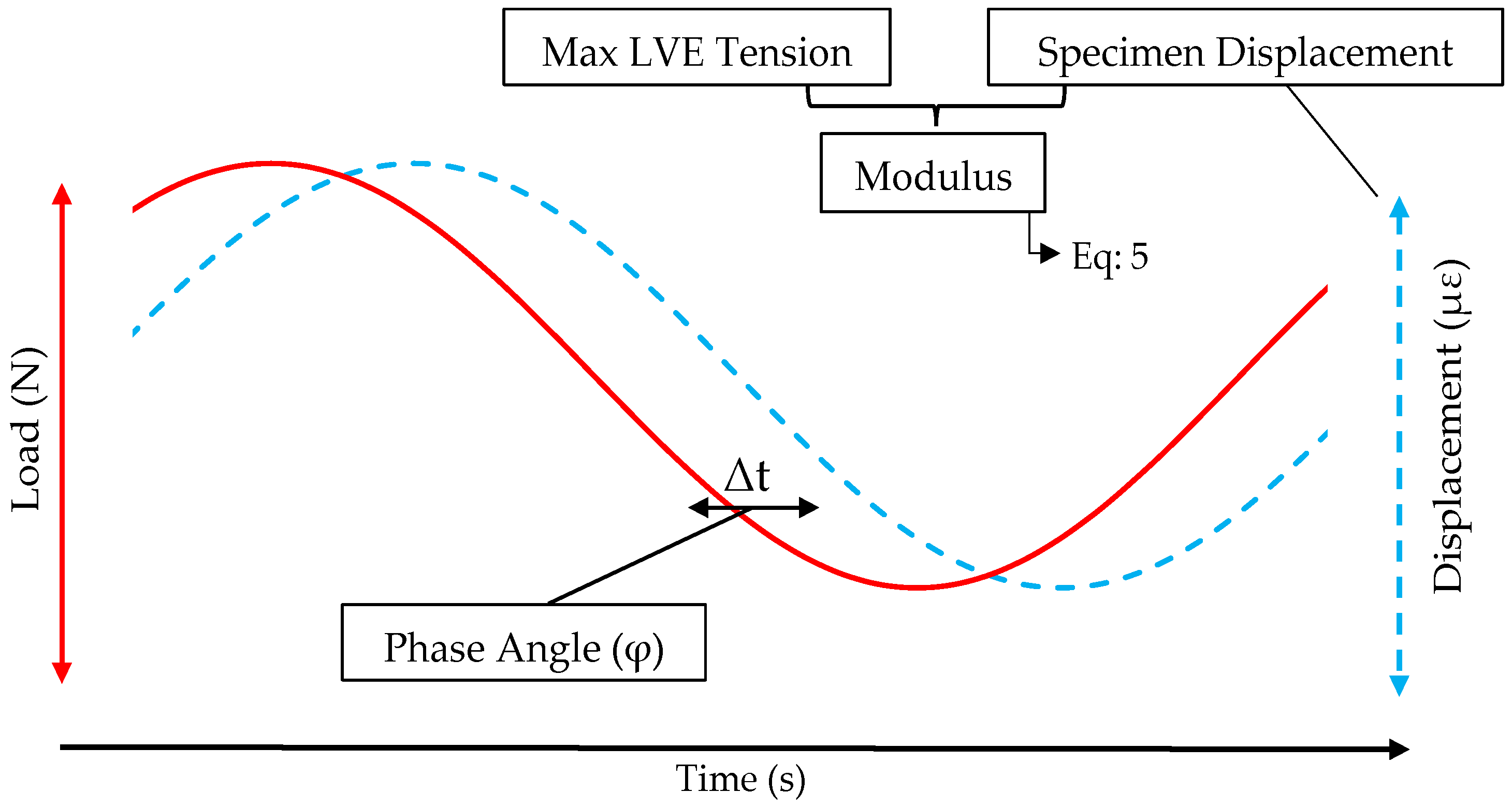
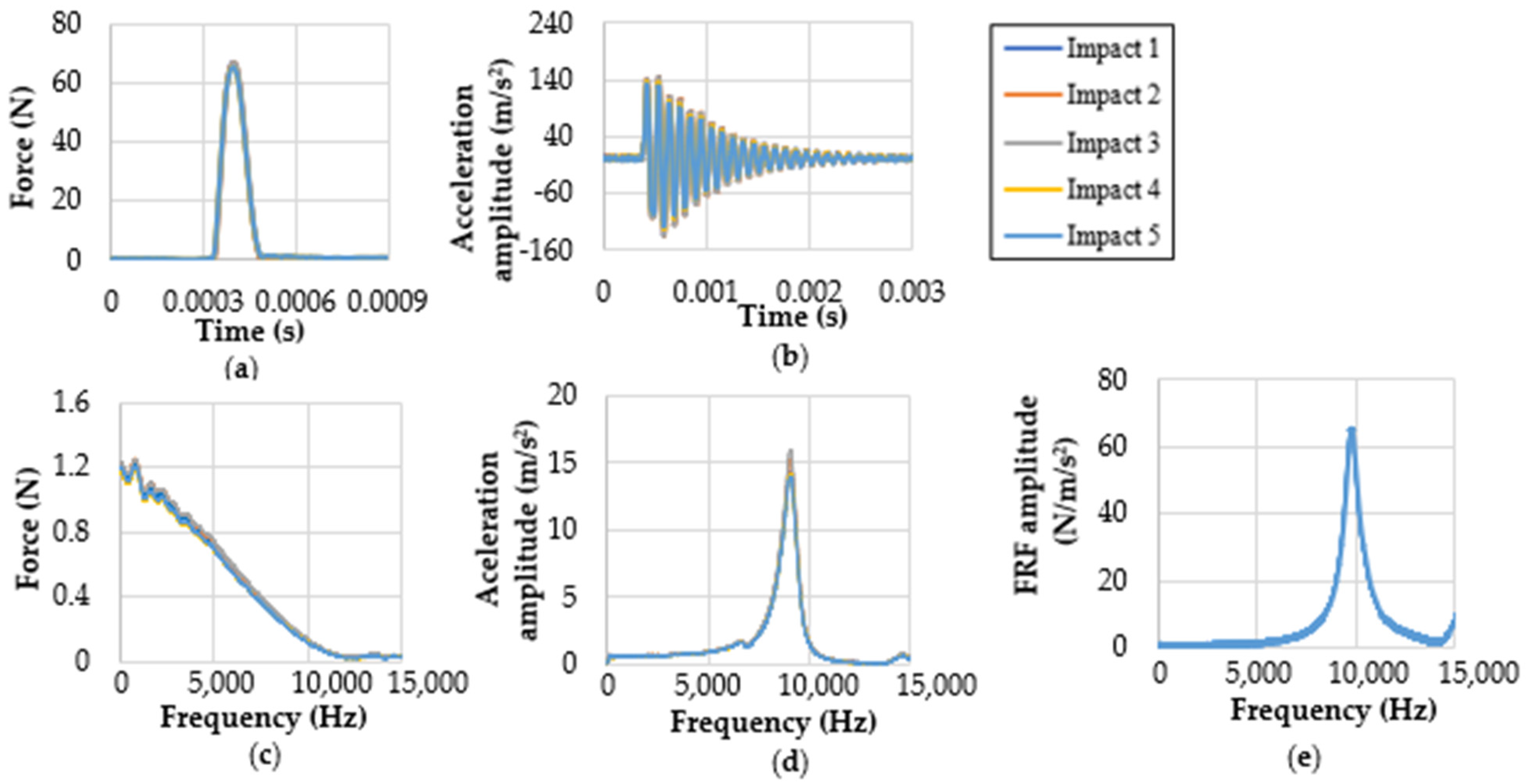
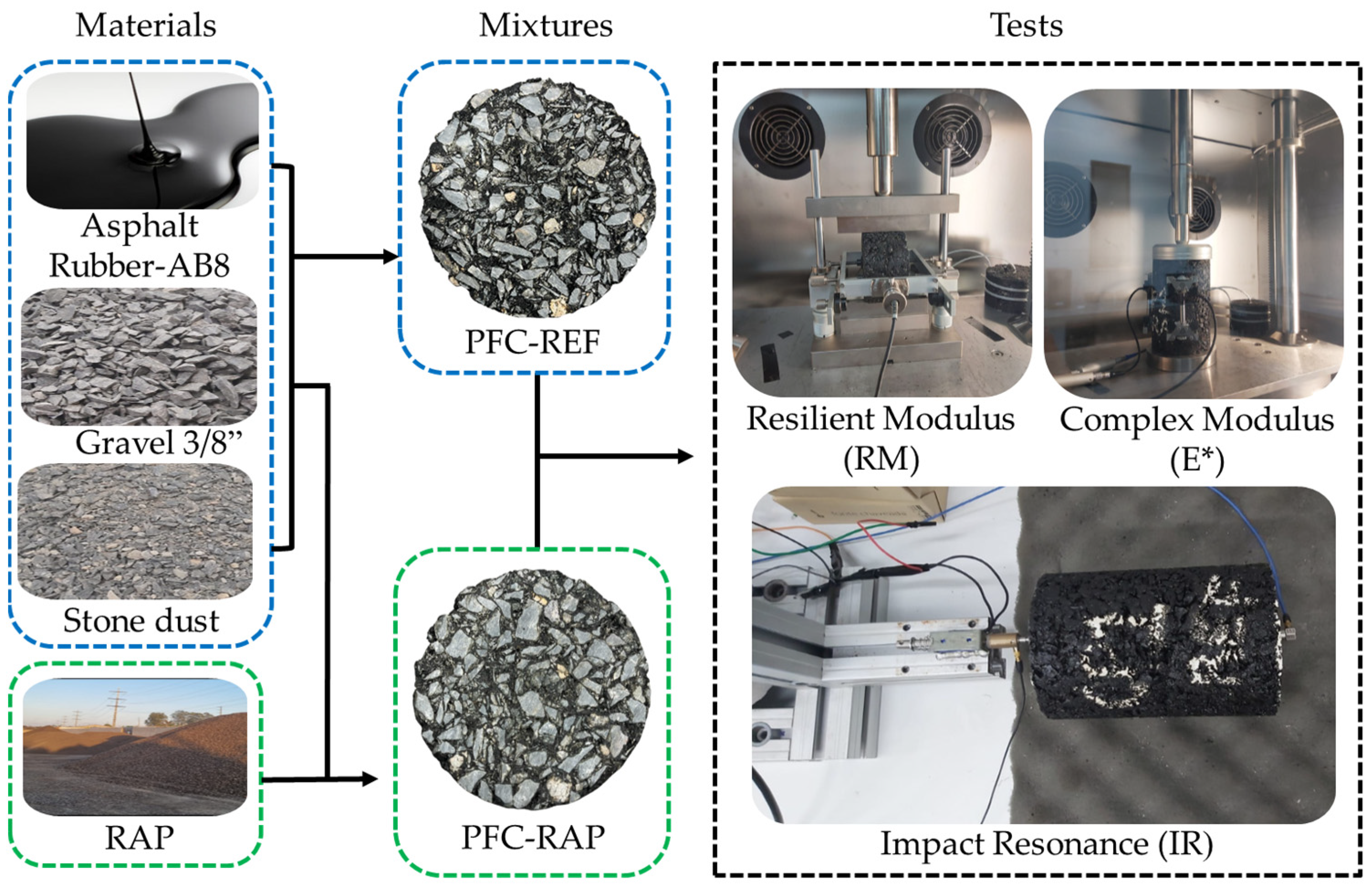
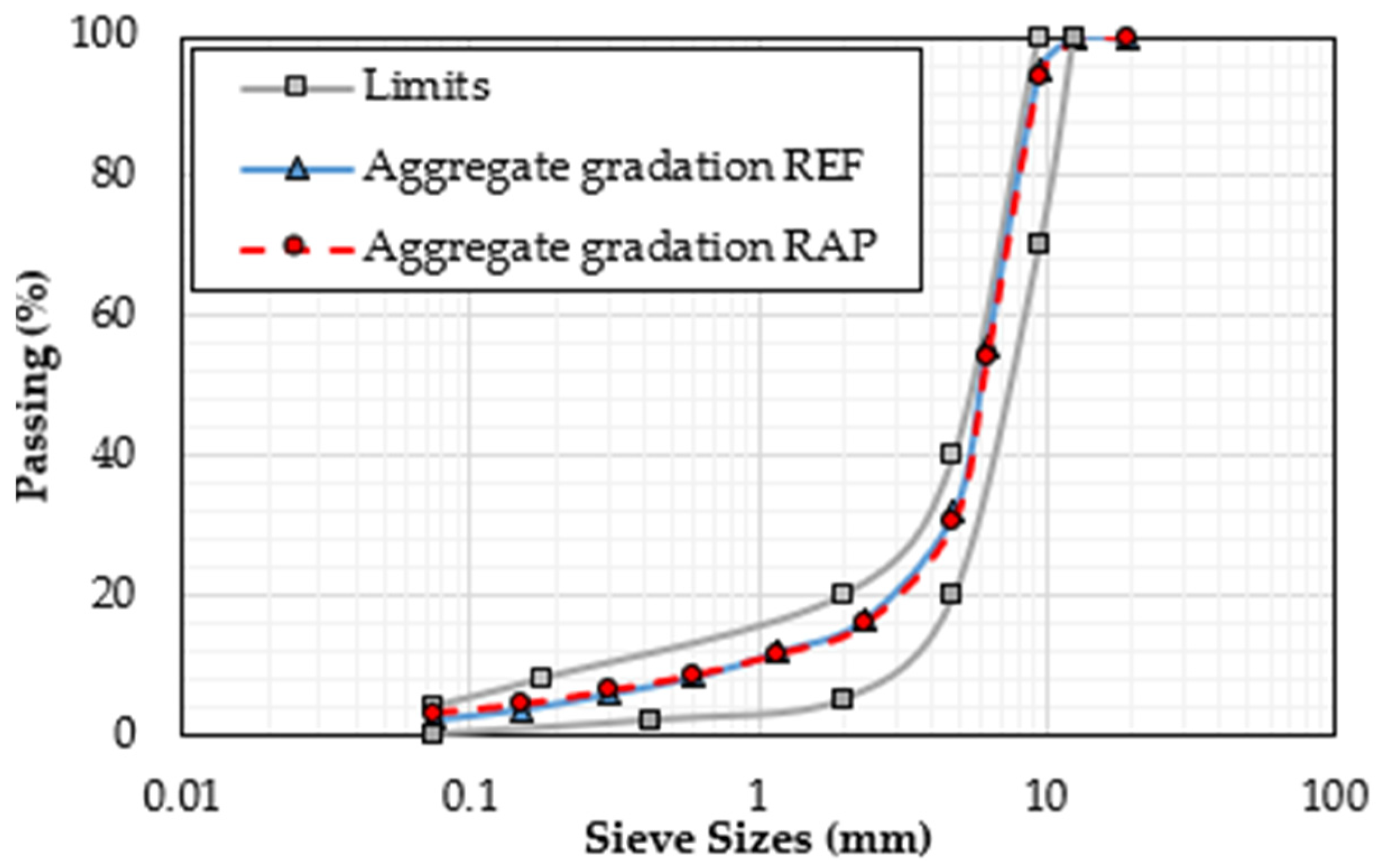
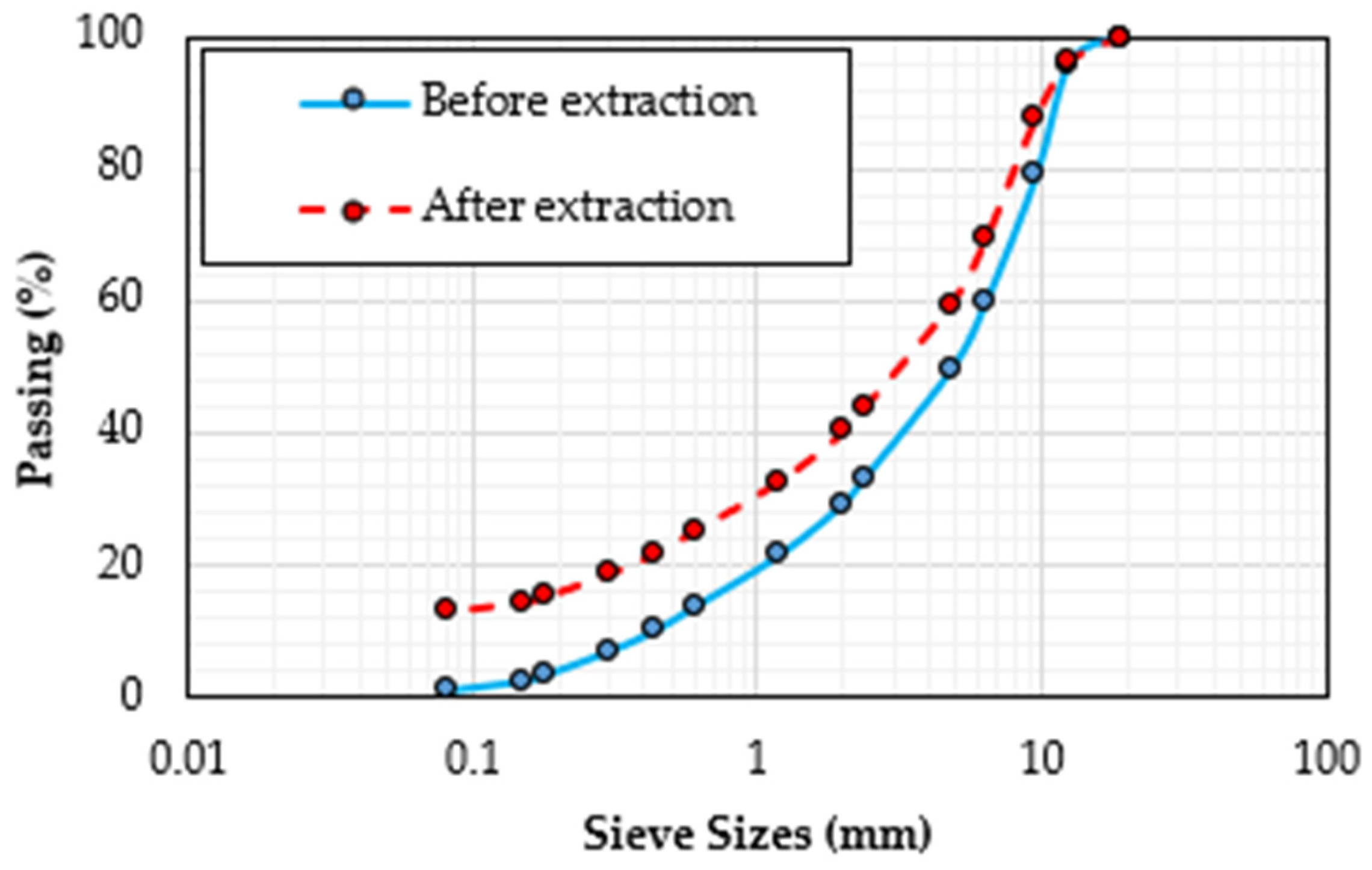
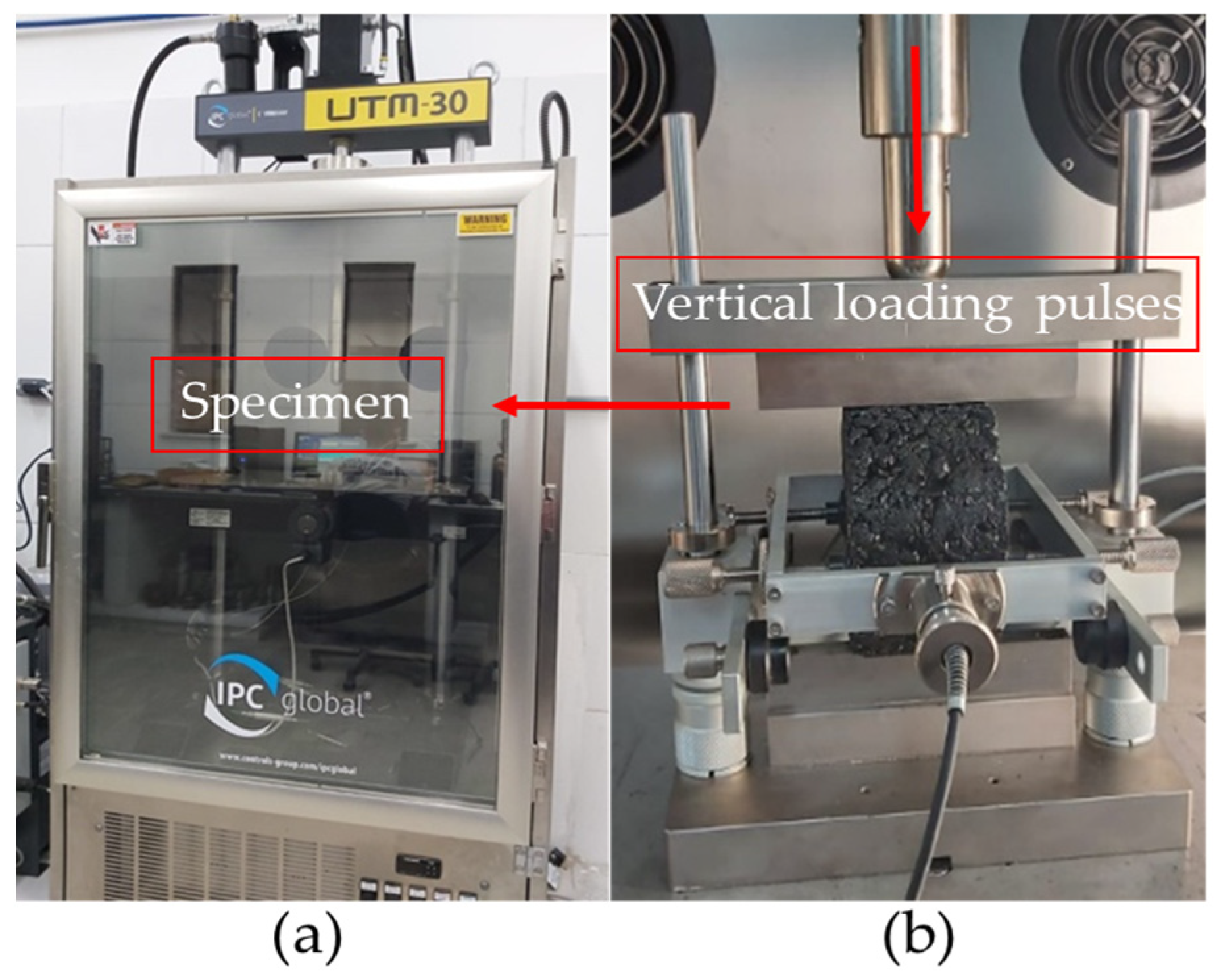


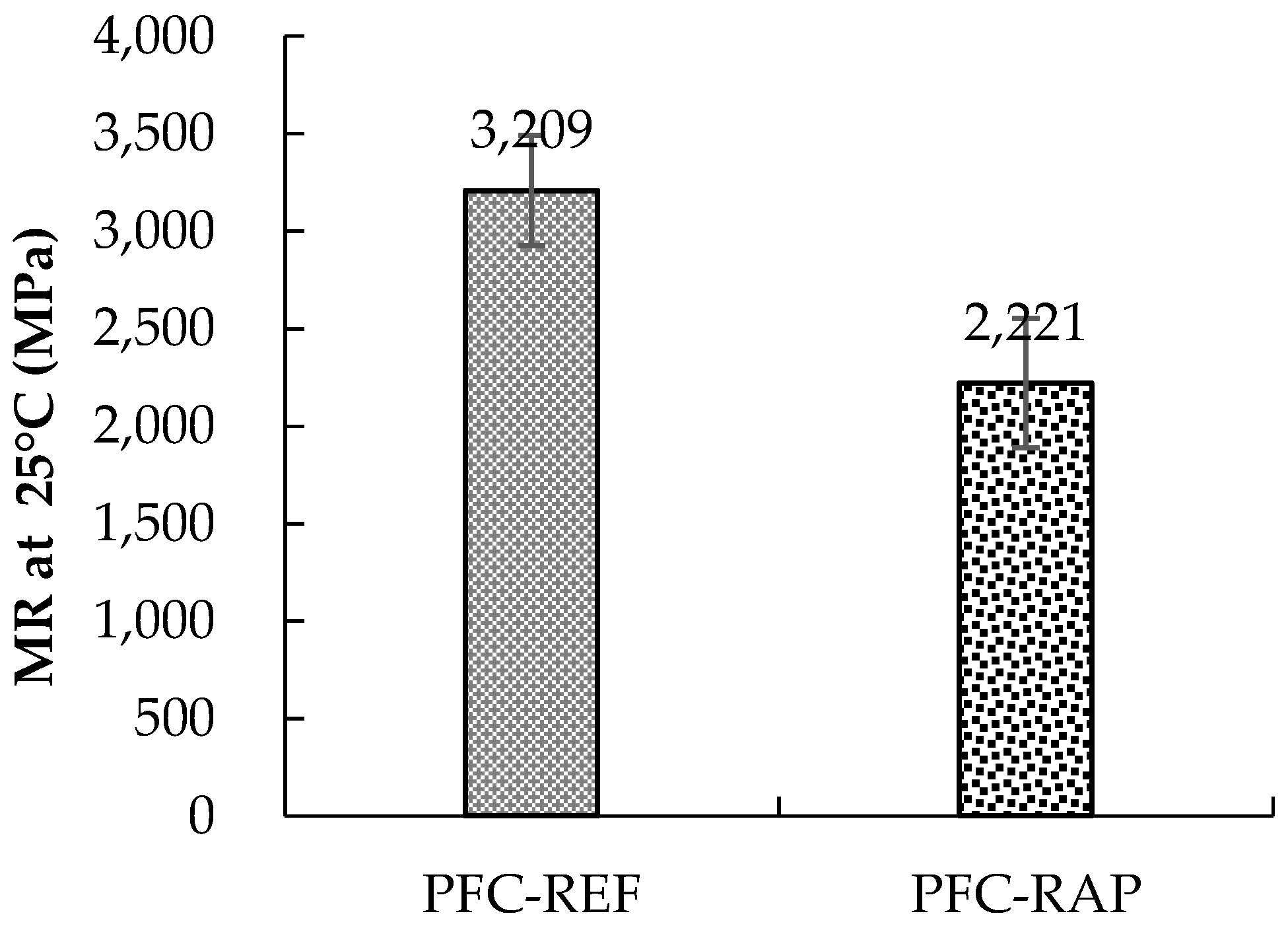

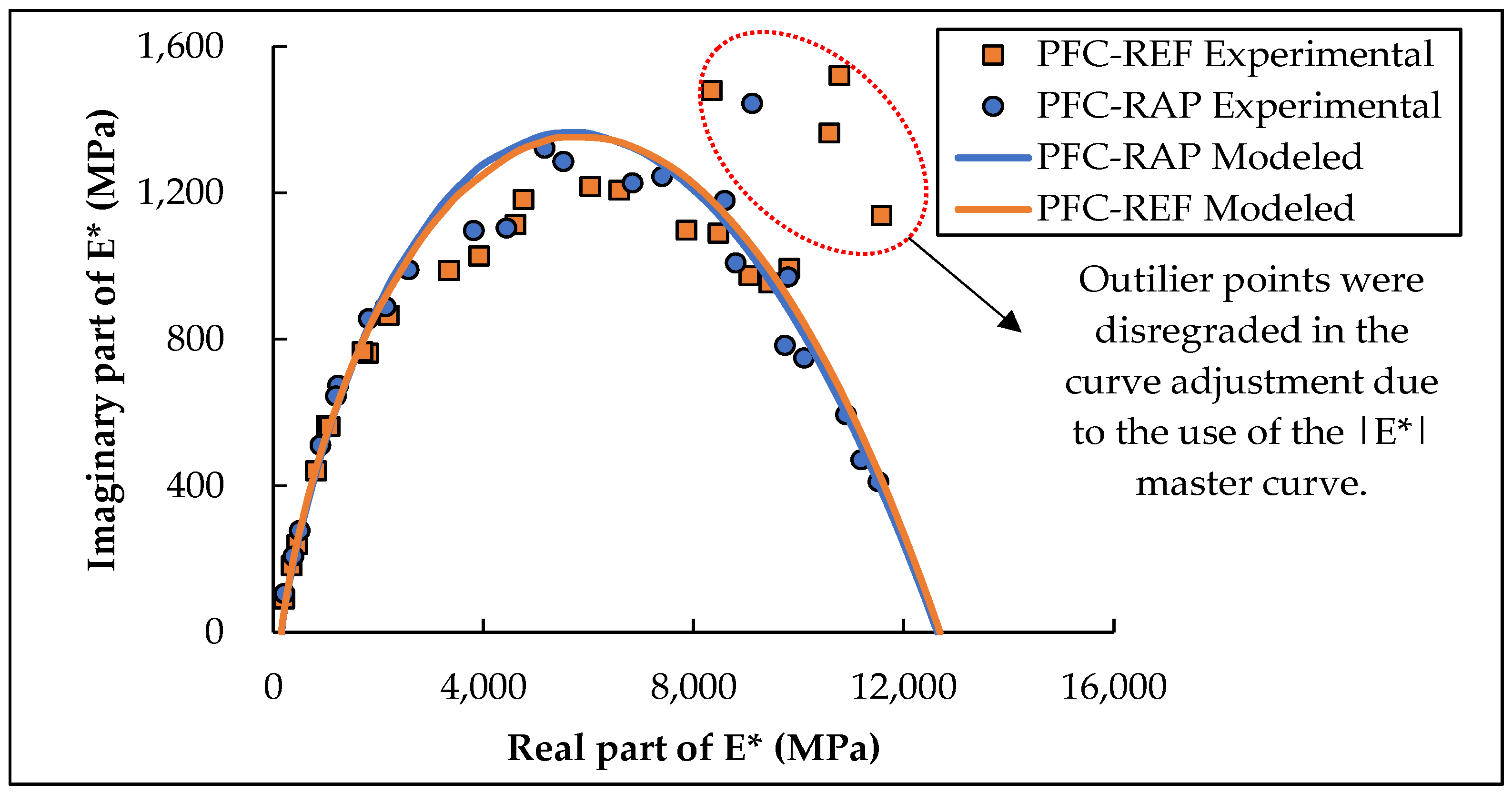
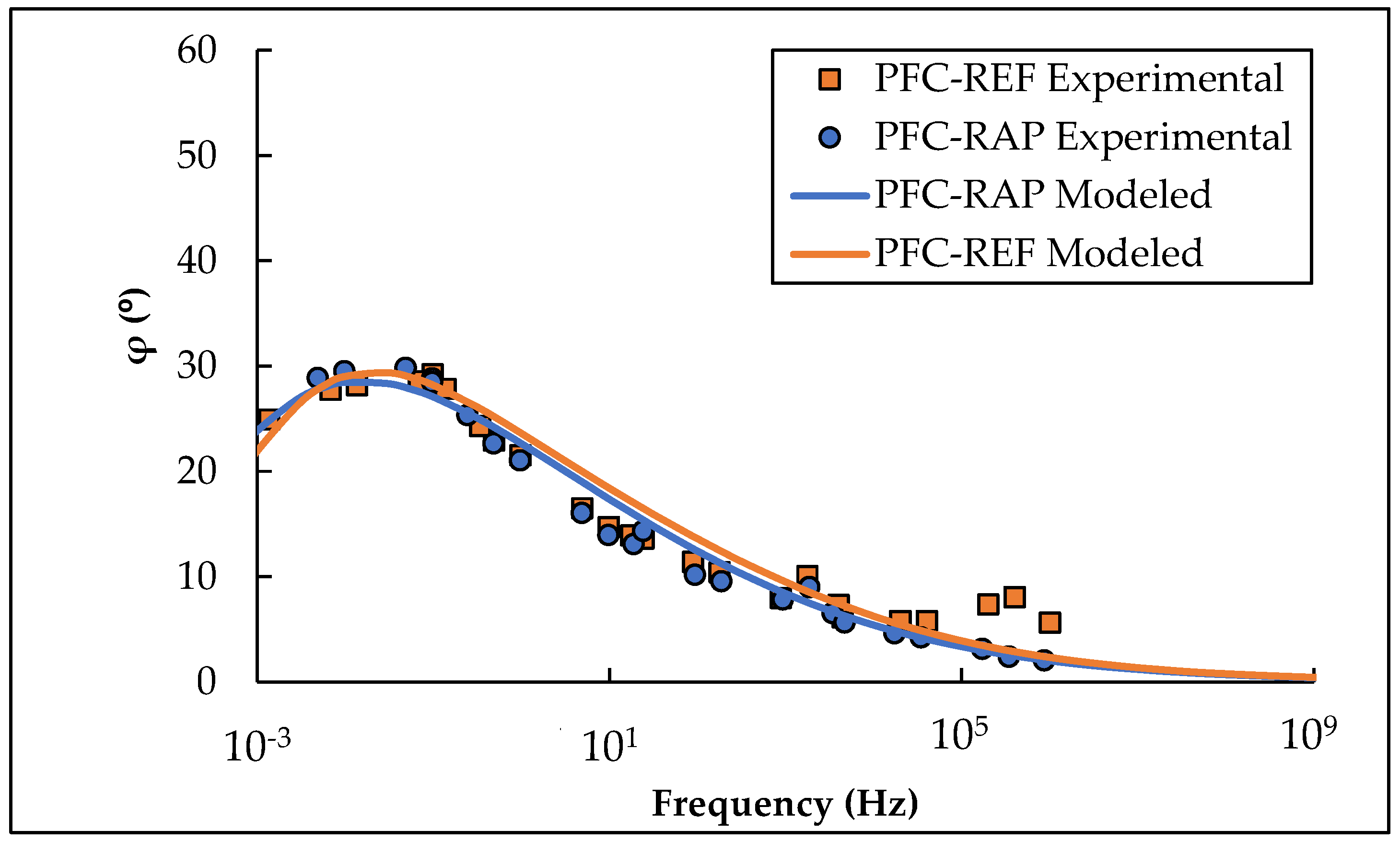
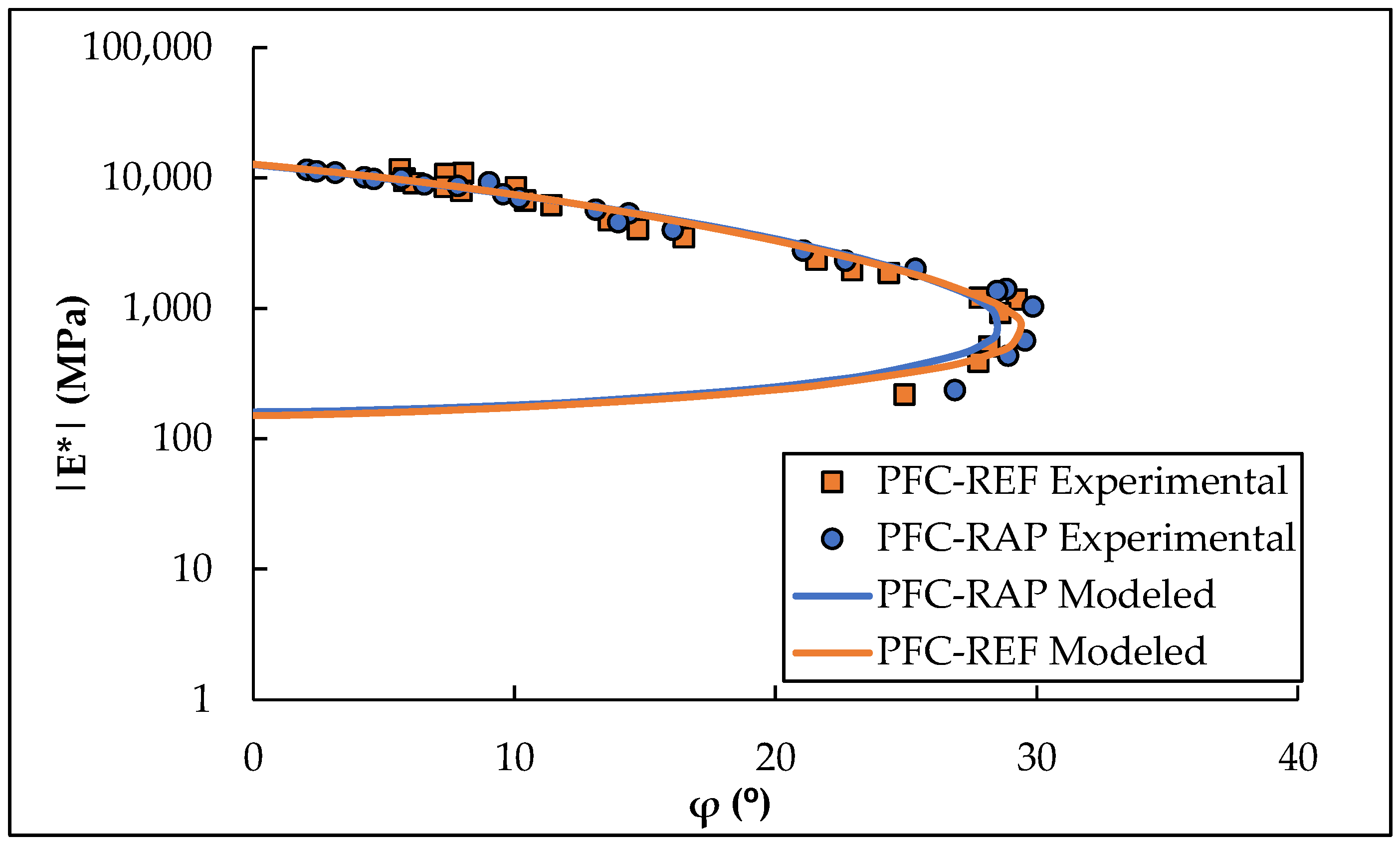
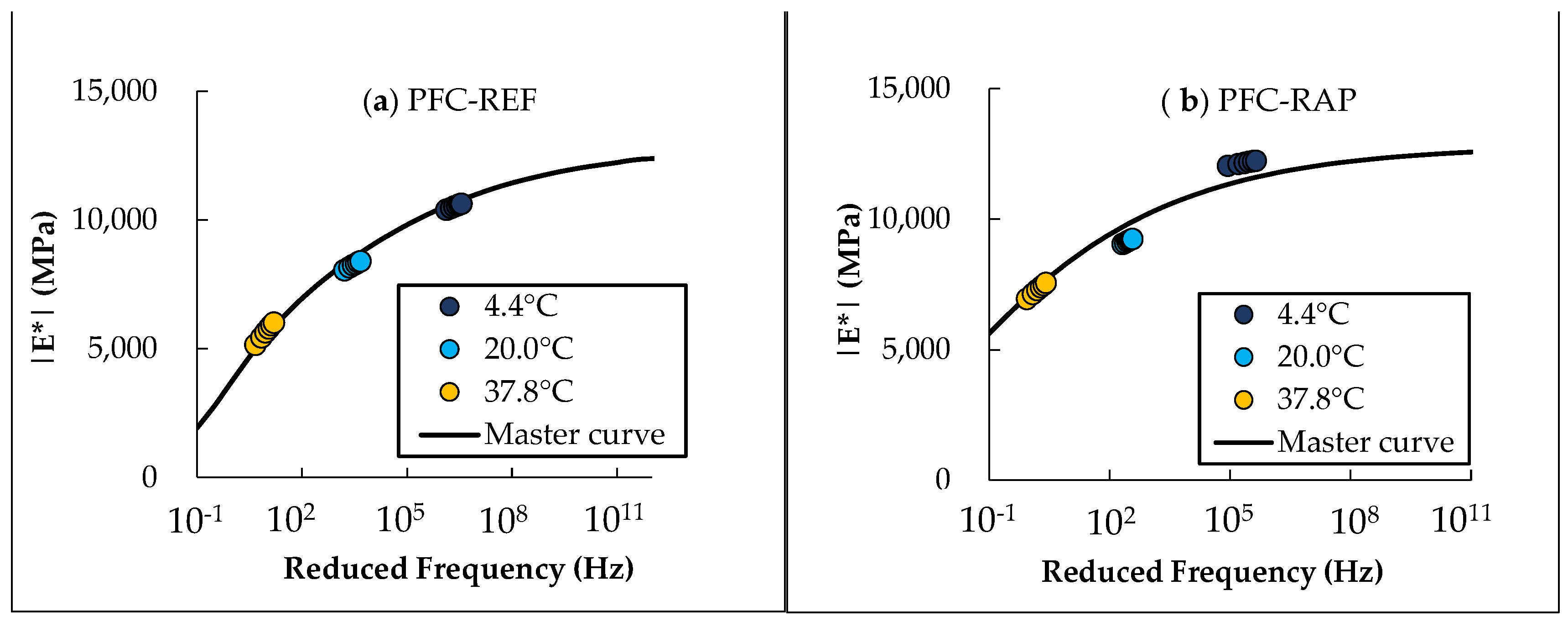
| Mixtures | E* | WFL | |||||||
|---|---|---|---|---|---|---|---|---|---|
| E∞ (MPa) | E0 (MPa) | k | h | Δ | tE (s) | β | C1 | C2 | |
| PFC-REF | 150 | 12,700 | 0.25 | 0.56 | 3.24 | 0.085 | 250 | 20.31 | 167.02 |
| PFC-RAP | 160 | 12,650 | 0.24 | 0.51 | 2.45 | 0.080 | 150 | 29.44 | 231.76 |
Disclaimer/Publisher’s Note: The statements, opinions and data contained in all publications are solely those of the individual author(s) and contributor(s) and not of MDPI and/or the editor(s). MDPI and/or the editor(s) disclaim responsibility for any injury to people or property resulting from any ideas, methods, instructions or products referred to in the content. |
© 2024 by the authors. Licensee MDPI, Basel, Switzerland. This article is an open access article distributed under the terms and conditions of the Creative Commons Attribution (CC BY) license (https://creativecommons.org/licenses/by/4.0/).
Share and Cite
Barbosa, E.; Lira, L.; Filho, M.S.; Babadopulos, L.; Soares, J.; Santos, G.; Bastos, J. Mechanical Analysis through Non-Destructive Testing of Recycled Porous Friction Course Asphalt Mixture. Buildings 2024, 14, 2907. https://doi.org/10.3390/buildings14092907
Barbosa E, Lira L, Filho MS, Babadopulos L, Soares J, Santos G, Bastos J. Mechanical Analysis through Non-Destructive Testing of Recycled Porous Friction Course Asphalt Mixture. Buildings. 2024; 14(9):2907. https://doi.org/10.3390/buildings14092907
Chicago/Turabian StyleBarbosa, Eulália, Lucas Lira, Mauro Silva Filho, Lucas Babadopulos, Jorge Soares, Gemmelle Santos, and Juceline Bastos. 2024. "Mechanical Analysis through Non-Destructive Testing of Recycled Porous Friction Course Asphalt Mixture" Buildings 14, no. 9: 2907. https://doi.org/10.3390/buildings14092907






